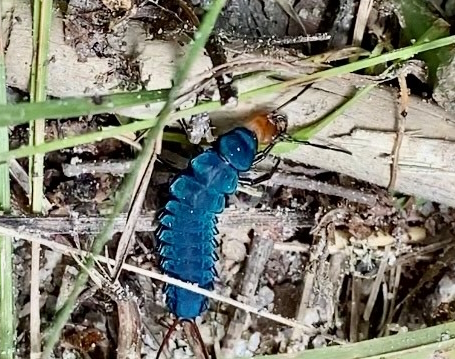Kathy first wrote to Ask a Naturalist® with remarkably generous concern for a bryozoan colony that had been marooned by the lowering water level in a reservoir. She was correctly worried that it would dry out and the colony would die. I often receive questions about these crazy “jelly-like blobs” growing under a dock, but most people want to know how to get rid of them, not save them. I suggested Kathy simply cut the branch and drop the colony into the water, and she’s been writing to me ever since.
Her most recent questions were not about jelly-like blobs, but about insects, and I see a thread in them, so I’m wondering today about things that look like caterpillars.
A while back, Kathy asked about a large “moth-like” insect with mandibles. That turned out to be a Dobson fly (Corydalinae), an insect that is a bit scary. It has a large caterpillar-like aquatic larvae called a hellgrammite, that also has frightening mandibles. Then, Kathy sent a photo of a beautiful blue caterpillar-like creature that is the larvae of a ground beetle, probably the notched-mouth ground beetle (Dicaelus purpuratus). More recently, she sent a great picture of a butternut wooly worm (Eriocampa juglandis), which is crazy looking, but underneath all that fluff also looks like a caterpillar. The wooly worm is, however, the larvae of a saw fly, a group of insects related to wasps. Other sawfly larvae also look like caterpillars.
The name wooly worm is reminiscent of the wooly bear (Pyrrharctia), a familiar orange and black creature which is the only one of these examples that actually is a caterpillar.
There has been considerable coverage in scientific media in recent months about carcinization, which is the term given to the process by which decapod crustaceans, which include lobsters and shrimp, evolve into a flattened, sideways-walking crab shape. The evidence suggests that this has happened at least five times in the roughly 400 million years of decapod evolution. So scientists have been asking “What is it that makes the crab-like shape so successful?”
In fact, of the 15,000 or so species of decapods, about half have a crab-like shape.
I’m asking a similar question. “What makes the sinuous shape of a caterpillar so successful that a similar form has evolved in so many widely separated orders of insects?” I don’t know the answer, and I wasn’t able to find any research on this question, so if anyone is studying this question, please let me know.
And thanks, Kathy for all the questions and great photos!
Tom

Dobson fly

Hellgrammite

Ground beetle larvae

Butternut wooly worm

Banded wooly bear


I’m thrilled to read your write-up! Thank you so much for taking the time. Also…I’m grateful for all your help with identifying these most interesting species. I’m also intrigued by your question about the shape of the caterpillar and evolution. Fascinating thoughts. Thanks for all your hard work!